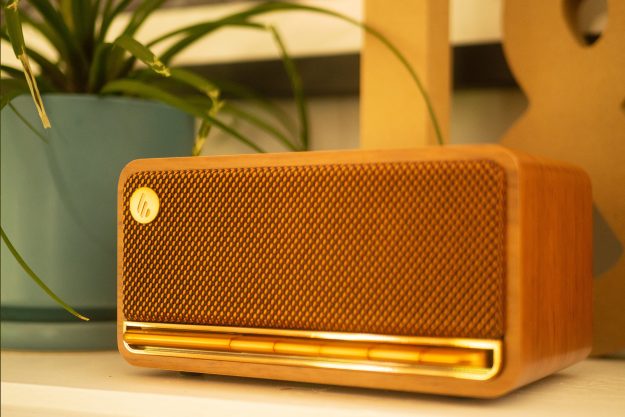“The Squeezebox Radio joins a long list of fabulous audio-streaming devices to emerge from Logitech’s labs.”
- Color display; tight integration with online services
- such as Facebook; robust server software; compact and portable; good sound
- Not outfitted with stereo speakers; remote control is optional; uses an 802.11g Wi-Fi radio
Summary
Logitech lopped a few features off the Squeezebox Boom, added several others—including a beautiful 2.4-inch display—and whacked $100 off the price tag to come up with the Squeezebox Radio, a phenomenal value among audio-streaming devices. The Boom sounds a little better than the Radio (especially when you’re comparing the speakers built into each box), but that advantage largely disappears when you use outboard speakers. And the Radio’s display adds a host of features the Boom can’t match.
Design and Features
The Squeezebox Radio has just one ¾-inch tweeter and one 3.0-inch long-throw woofer on the left side of the cabinet, which reduces its width by about one-third compared to the Squeezebox Boom. The integrated amplifier and speakers are merely adequate for background music: If you want more oomph, you can plug a set of powered speakers into the Radio’s 1/8-inch headphone jack (or connect it to your hi-fi system).
The display, a large push-button wheel, and a host of buttons take up the right side of the box. The display defaults to showing the artist’s name, track and album title, and album art; alternatively, you can program it to play slideshows using photos associated with your online Flickr account (either while it’s streaming music or when it’s otherwise idle). But the display has other uses, too. Log into your Slacker, LastFM, Pandora, or Rhapsody account, for instance, and you can give the current artist a thumb’s up or thumb’s down, read a biographical sketch of the artist, find other performers in a similar vein, or create a new custom radio station based on that artist’s style.

Have an account with more than one radio service? You can also jump from that artist’s station on one service to a similar station on another. Like a song so much you want to buy the whole CD? Navigate to Amazon with a few twists of and pushes on the control wheel and add it to your shopping cart. Sadly though, you can’t buy just one track, though, and you’ll need a PC to consummate the deal.
You can link your Facebook account to your Squeezebox Radio too. Once you have, you’ll be able to show Facebook news feeds and photos on the Radio’s display, navigate to your friends’ Facebook pages right from the Radio, or post messages about whatever song you’re listening to on your own Facebook profile. Those last posts come with no fewer than three links to Logitech websites, though; if you want a link to information about the song or the artist, you’ll have to do it yourself from within Facebook. You can do many of these things with the Squeezebox Boom, too, but the Radio’s display makes it all so much easier.

Six preset buttons border the display – these can be associated with your favorite radio stations or individual songs. The Radio has three functions on its face that we sorely missed on the Boom: The Home button, which takes you to the player’s root menu; the Alarm button, which takes you directly to the alarm-clock settings; and a good old-fashioned volume control knob with push-button mute. Unlike the Boom, however, the Radio doesn’t come with a remote control. The Radio is equipped with an infrared receiver, and Logitech plans to sell the same remote that comes with the Boom–plus a rechargeable battery that will render the Radio truly wireless—as an after-sale accessory. The $49.99 package is scheduled to be available in November. But if you buy the Squeezebox Radio, we’d recommend living with it for a while before plunking down any extra cash. We’ve been using a Squeezebox Boom almost daily for several months and have found that we rarely use the remote.

The Squeezebox Radio couldn’t be much easier to install, whether you connect to a wired or wireless network. We had our unit up and running on our wireless network inside of 10 minutes (add a few minutes to that if you don’t already have an account at mysqueezebox.com, and a few minutes more to install and configure Logitech’s outstanding Squeezebox Server software).
Conclusion
The Squeezebox Radio joins a long list of fabulous audio-streaming devices to emerge from Logitech’s labs, and all of them can be used together to assemble a very economical multi-room music system (although the Sonos Digital Music System remains our top pick in that category). We do wish that Logitech would switch to an 802.11n wireless LAN chip though – the Squeezebox is the only device that’s preventing us from running our wireless network at top speed in 802.11n-only mode. We’re happier to report that the Squeezebox Radio does support WPA2 wireless security, and that it boasts excellent range: We connected to our wireless access point in every room of the 2800 square foot home we used for testing. But the device’s display, as small as it is, is our favorite new feature. Displaying album art is all well and good, but the feature-laden LCD opened the door to some great possibilities we’d never thought of.
Pros
- Color display
- Strong integration with online services
- Robust server software
- Compact and portable
- Good sound
- Fabulous price/performance ratio
Cons
- Lacks stereo speakers
- Remote control costs extra
- Uses an 802.11g Wi-Fi radio
Editors' Recommendations
- SiriusXM’s Taylor Swift channel is free if your car has satellite radio
- SiriusXM reboots satellite radio with new app, features — and price
- The best universal remotes for 2023
- Updating our Sony WF-1000XM5 review
- Samsung S95C OLED hands-on review: it’s time to get excited



